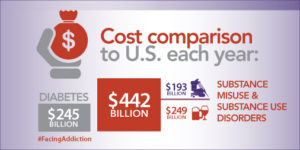President-elect Trump takes office in the midst of a devastating opioid epidemic. As he begins to grapple with the causes and solutions of this growing national tragedy, Odyssey House President Dr. Peter Provet offers ten fundamental points to anchor his efforts.
1: Treatment works. But there isn’t enough of it. Approximately 14 percent of Americans with substance abuse problems are able to get the appropriate treatment they need to stop using drugs, maintain a drug-free lifestyle, and be functional – and contributing – members of society, at work, and in the family. This means of the 21.7 million adults and teenagers who are addicted to legal and illegal substances, only 3 million people get the help they need.
2: Addiction does not discriminate. Substance abuse is a health problem that destroys the lives of men and women, young and old, from all ethnic backgrounds and communities. Today’s opioid epidemic is devastating families across the country. Prescription pain reliever overdose deaths among women have increased more than 400 percent from 1999-2010, compared to a 237 percent among men, and the number of deaths from heroin among women tripled from 2010 to 2013. Adolescents are using prescription pain relievers for nonmedical needs in large numbers: in 2015, 276,000 teenagers were current nonmedical users of pain relievers, with 122,000 having an addiction to prescription pain relievers.
3: Drug overdose is the leading cause of accidental death in the US. Of the 47,055 lethal overdoses in 2014, opioids claimed the lives of 29,467 Americans, with prescription pain relievers related to 18,893 overdose deaths and heroin 10,574. In all, opioid overdose deaths claim the lives of 91 Americans a day.
4: The tragedy is that a great many of these lives can be saved and for as little as $75 or less. Treatment centers, hospitals, police forces, fire departments, and other community organizations are training their personnel in the use of naloxone – a life-saving, easy-to-administer drug, proven to reverse opioid overdose death. A 2013 survey of organizations who provide naloxone to laypersons who might witness an overdose, including persons who use drugs, their families and friends, and service providers, received reports of 26,463 overdose reversals. The role of naloxone in saving people from a potentially fatal opioid overdose is dramatic: a 160 percent increase in the number of reversals reported; a 243 percent increase in the number of local sites providing naloxone; a 187 percent increase the number of laypersons provided naloxone kits; and a 94 percent increase in states with at least one organization providing naloxone.
5: While the human cost of addiction can be devastating, the financial burden on all Americans is staggering. The US spends more than $700 billion annually in costs related to health care, lost work productivity, and crime. Abuse of illicit drugs alone costs $193 billion.
6: The cost of treatment for substance abuse disorders pales in comparison to the costs of abuse. Publicly-funded, residential treatment administered professionally using evidence-based programs costs $62 a day. In-hospital opioid detox starts at $1,000 a day. In 2012, New York City paid $460 a day to feed, house, and guard each inmate, the majority nonviolent drug offenders.
7: Funding for treatment has not kept up with demand. When the Comprehensive Addiction Recovery Act (CARA) was passed into law in July 2016, it was the most significant federal legislation on addiction treatment in 40 years. CARA received overwhelming bi-partisan support in Congress and the Senate. It was hailed as the most comprehensive effort undertaken to address the opioid epidemic, encompassing all six pillars necessary for such a coordinated response – prevention, treatment, recovery, law enforcement, criminal justice reform, and overdose reversal. But the funding request was drastically reduced from $1Billion to $181Million.
Now we have cause to be hopeful that funding will be restored. Just this month the US House of Representatives passed HR 34, The 21st Century Cures Act. The legislation provides $1Billion over several years to states through the existing grant program for prevention, treatment, prescription drug monitoring programs, opioid treatment programs, and workforce development. The bill creates federal drug courts and programs for alternatives to incarceration for individuals with SUD. It also encourages the integration of care for SUD with primary care.
This landmark legislation – a turning point for addiction treatment and prevention – has now been signed by President Obama.
8: As demand for treatment increases, we are faced with a growing workforce crisis in the addictions field. This crisis is due to a variety of factors, including stigma, an aging workforce, and inadequate compensation. A report to Congress from the Substance Abuse and Mental Health Services Administration (SAMHSA) warned that the addiction services field will need to fill more than 330,000 jobs to keep pace with demand for care.
9: Addiction is a brain disease to be treated, not a criminal justice issue to be punished. A decade or more of scientific research has conclusively shown addiction is a disease that affects both the brain and behavior. Science has identified many of the biological and environmental factors and is beginning to search for the genetic variations that contribute to the development and progression of the disease.
10: Voters in eight states approved passage of marijuana laws ranging from full legalization of recreational use of marijuana to approving or easing of restrictions for medical marijuana laws. These laws will have undoubtedly increase marijuana use – and misuse. Keeping marijuana out of the hands of youth is everyone’s concern. Ensuring prevention and treatment programs are ready to help those, is everyone’s commitment.


 It can’t go on. The death rate from what is a preventable, and treatable disease, is unconscionable. The financial costs are unsustainable.
It can’t go on. The death rate from what is a preventable, and treatable disease, is unconscionable. The financial costs are unsustainable.